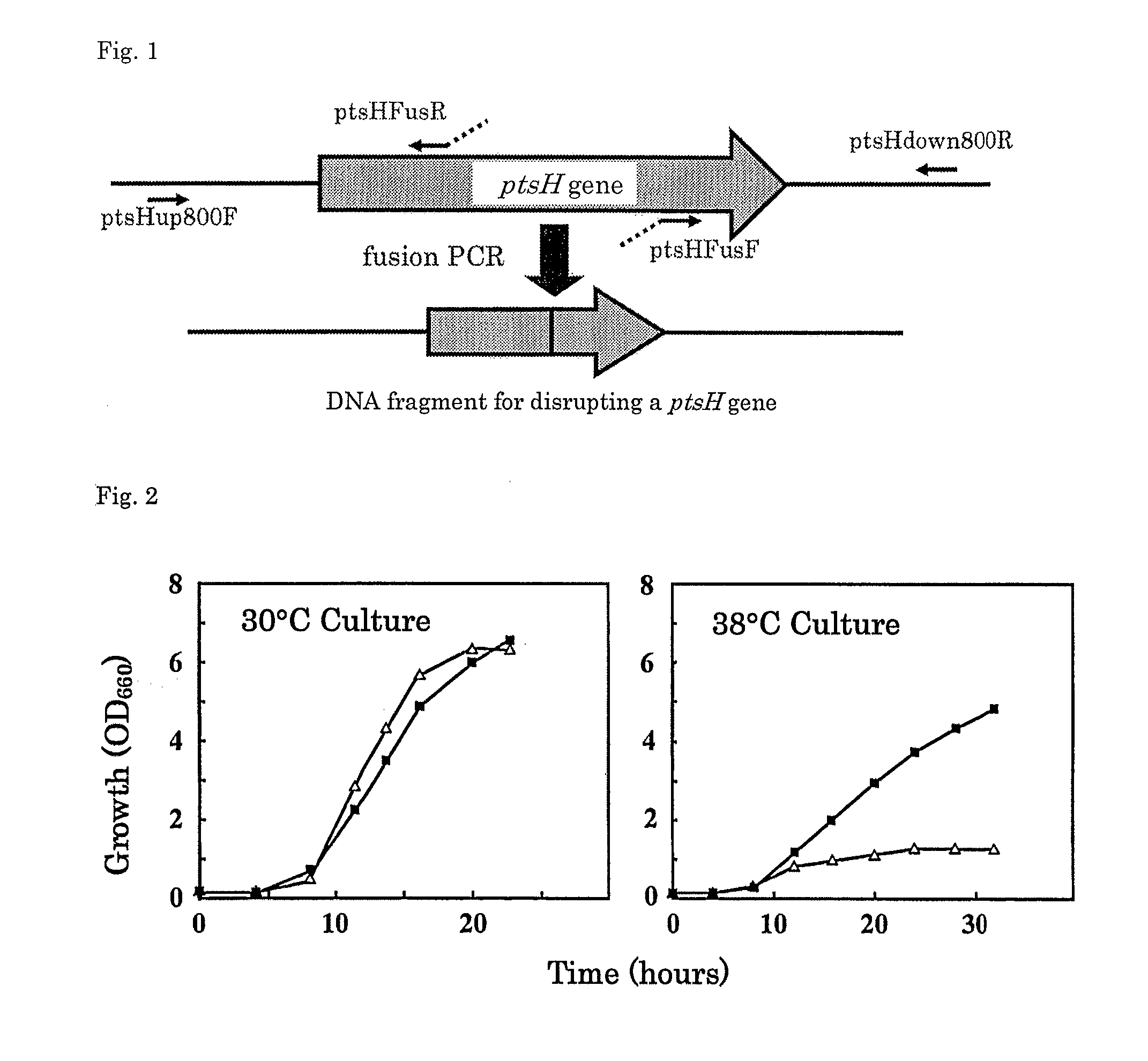Process for producing useful substance
a technology of useful substances and processes, applied in the direction of microorganisms, peptides, bacteria based processes, etc., can solve the problems of low productivity, poor growth, and system unknown, and achieve the effect of efficient production of useful substances
- Summary
- Abstract
- Description
- Claims
- Application Information
AI Technical Summary
Benefits of technology
Problems solved by technology
Method used
Image
Examples
example 1
(1) Construction of a DNA Fragment for Disrupting ptsH Gene
[0113]Based on genomic information on the Corynebacterium glutamicum wild-type strain ATCC13032 obtained from DNA Data Bank of Japan (DDBJ) (http: / / gib.genes.nig.ac.jp / single / index.php?spid=CgluATCC13032), two primers (ptsHup800F; SEQ ID NO: 1, and ptsHFusR; SEQ ID NO: 2) for amplifying the upstream region of ptsH [Gene Number: Cgl1937 (NCgl1862)], and two primers for amplifying the downstream region of ptsH (ptsHdown800R; SEQ ID NO: 3 and ptsHFusF; SEQ ID NO: 4) were designed.
[0114]To perform second PCR (fusion PCR) for ligating the upstream and downstream fragments amplified by the first PCR, DNA comprising the nucleotide sequence complementary to about 25 nucleotide sequence at 3′ end of the 5′-primer (ptsHFusF; SEQ ID NO: 4) for downstream amplification was added to 5′ end of the 3′-primer (ptsHFusR; SEQ ID NO: 2) for upstream amplification, and DNA comprising the nucleotide sequence complementary to about 25 nucleotide ...
example 2
Production of L-Lysine Using the SupH Strain
[0136]lysC311 mutation was introduced into the SupH strain obtained in Example 1, according to the disclosure of Japanese Unexamined Patent Publication No. 2002-191370 (U.S. Pat. No. 7,332,310), to prepare a SupH (lysC311) strain.
[0137]One platinum loop amount of cells of the SupH(lysC311) strain cultured on the BY agar medium at 30° C. for 24 hours was inoculated into a large test tube containing 5 ml of seed medium (20 g of glucose, 7 g of meat extract, 10 g of peptone, 3 g of sodium chloride, and 5 g of yeast extract in 1 L of water, and adjusted to pH 7.2, after which 10 g of calcium carbonate was added), and cultured at 30° C. for 15 hours. 0.5 ml of this seed culture solution was inoculated into a large test tube containing 5 ml of main culture medium (50 g of glucose, 10 g of corn steep liquor, 45 g of ammonium sulfate, 2 g of urea, 0.5 g of potassium dihydrogen phosphate, 0.5 g of magnesium sulfate heptahydrate, and 0.3 mg of bioti...
example 3
Production Test of L-lysine using the SupH Strain
[0138]It is known that a L-lysine producing strain can be obtained by introducing lysC311 mutation (Thr311→Ile) into a Corynebacterium glutamicum wild-type strain (Japanese Unexamined Patent Publication No. 2002-191370, Appl. Microbiol. Biotechnol., 58, 217 (2002)). The method of introducing this mutation is also described in detail in Japanese unexamined patent publication (Japanese Unexamined Patent Publication No. 2002-191370). Based on such information, lysC311 mutation was introduced into the SupH strain obtained in Example 1 and its parent strain, ATCC31833 strain. The ATCC31833 strain and the SupH strain each containing lysC311 mutation were designated ATCC31833 (lysC311) strain and SupH (lysC311) strain, respectively.
[0139]Production test of L-lysine using the ATCC31833 strain (lysC311) and the SupH (lysC311) strain thus obtained was conducted by culturing those strains using a test tube in the following manner. One platinum l...
PUM
| Property | Measurement | Unit |
|---|---|---|
| pH | aaaaa | aaaaa |
| concentration | aaaaa | aaaaa |
| pH | aaaaa | aaaaa |
Abstract
Description
Claims
Application Information
 Login to View More
Login to View More - R&D
- Intellectual Property
- Life Sciences
- Materials
- Tech Scout
- Unparalleled Data Quality
- Higher Quality Content
- 60% Fewer Hallucinations
Browse by: Latest US Patents, China's latest patents, Technical Efficacy Thesaurus, Application Domain, Technology Topic, Popular Technical Reports.
© 2025 PatSnap. All rights reserved.Legal|Privacy policy|Modern Slavery Act Transparency Statement|Sitemap|About US| Contact US: help@patsnap.com

